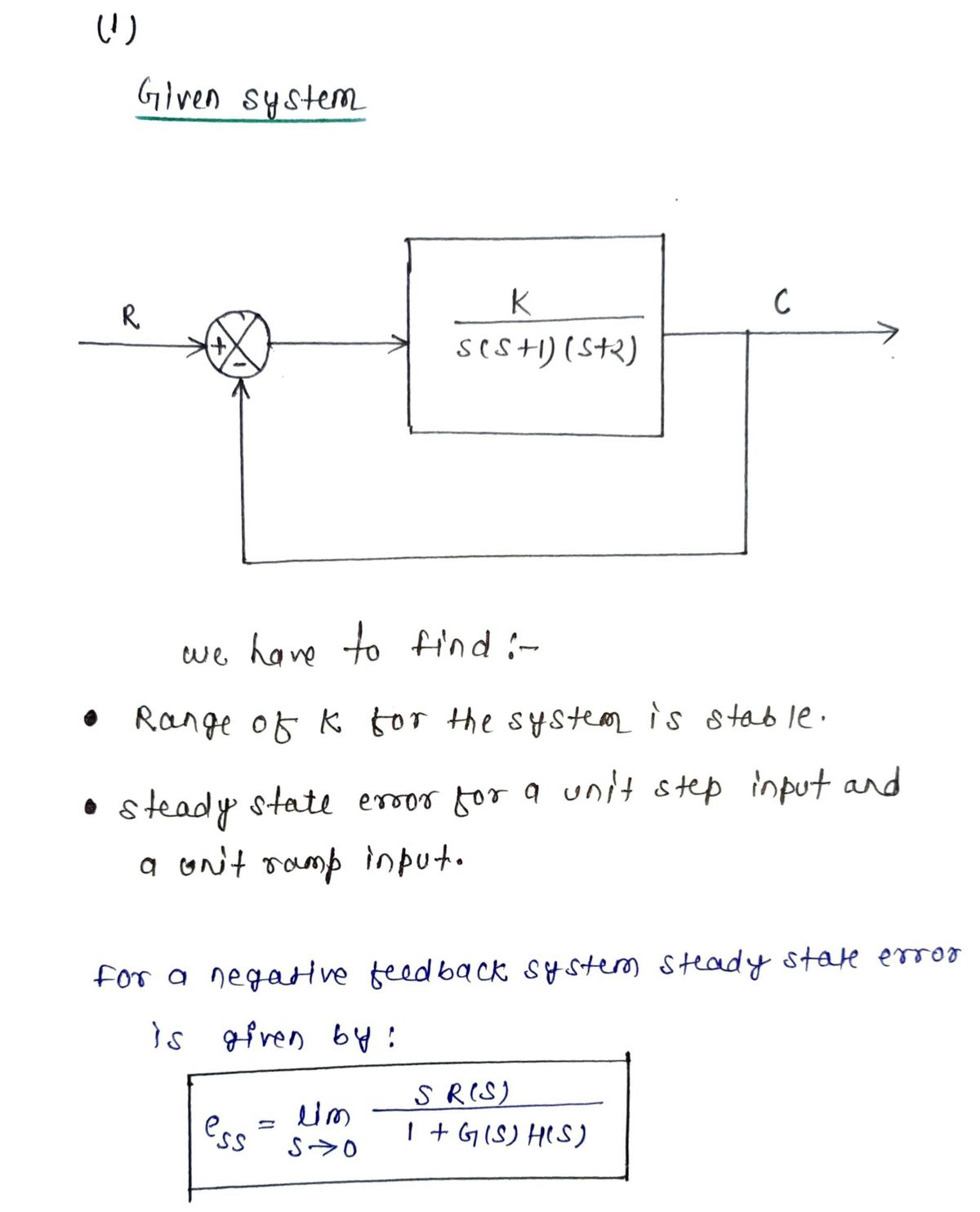For the system shown below do the following: R Determine the range of K for the system to be stable Determine the steady state error for a unit step input and a unit ramp input K s(s+1)(s+2) C
For the system shown below do the following: R Determine the range of K for the system to be stable Determine the steady state error for a unit step input and a unit ramp input K s(s+1)(s+2) C
Introductory Circuit Analysis (13th Edition)
13th Edition
ISBN:9780133923605
Author:Robert L. Boylestad
Publisher:Robert L. Boylestad
Chapter1: Introduction
Section: Chapter Questions
Problem 1P: Visit your local library (at school or home) and describe the extent to which it provides literature...
Related questions
Question

Transcribed Image Text:### Control System Analysis
#### Problem Statement:
For the system shown in the diagram below, complete the following tasks:
- Determine the range of \( K \) for the system to be stable.
- Determine the steady-state error for a unit step input and a unit ramp input.
#### System Diagram:
The diagram represents a feedback control system with the following components:
- **Block Diagram Components:**
- **Input (\(\overline{R}\))**: The reference input to the system.
- **Summing Junction**: The input \(\overline{R}\) and the output \(\overline{C}\) are combined. The output is the error signal fed into the next block.
- **Transfer Function Block**: The system's transfer function is \(\frac{K}{s(s+1)(s+2)}\), where \( K \) is the gain.
- **Feedback Path**: The output \(\overline{C}\) is fed back and subtracted from the input \(\overline{R}\).
#### Objectives:
1. **Stability Analysis**:
- Determine the range of the gain \( K \) that ensures system stability. Use techniques such as the Routh-Hurwitz criterion or root locus analysis.
2. **Steady-State Error Calculation**:
- Use the final value theorem to calculate the steady-state error for:
- A unit step input.
- A unit ramp input.
The analysis involves examining the poles and zeros of the transfer function and assessing the impact of various inputs on system performance. Stability and error analysis are key to ensuring the desired behavior of the control system.
Expert Solution
Step 1

Step by step
Solved in 3 steps with 6 images

Knowledge Booster
Learn more about
Need a deep-dive on the concept behind this application? Look no further. Learn more about this topic, electrical-engineering and related others by exploring similar questions and additional content below.Recommended textbooks for you

Introductory Circuit Analysis (13th Edition)
Electrical Engineering
ISBN:
9780133923605
Author:
Robert L. Boylestad
Publisher:
PEARSON

Delmar's Standard Textbook Of Electricity
Electrical Engineering
ISBN:
9781337900348
Author:
Stephen L. Herman
Publisher:
Cengage Learning

Programmable Logic Controllers
Electrical Engineering
ISBN:
9780073373843
Author:
Frank D. Petruzella
Publisher:
McGraw-Hill Education

Introductory Circuit Analysis (13th Edition)
Electrical Engineering
ISBN:
9780133923605
Author:
Robert L. Boylestad
Publisher:
PEARSON

Delmar's Standard Textbook Of Electricity
Electrical Engineering
ISBN:
9781337900348
Author:
Stephen L. Herman
Publisher:
Cengage Learning

Programmable Logic Controllers
Electrical Engineering
ISBN:
9780073373843
Author:
Frank D. Petruzella
Publisher:
McGraw-Hill Education

Fundamentals of Electric Circuits
Electrical Engineering
ISBN:
9780078028229
Author:
Charles K Alexander, Matthew Sadiku
Publisher:
McGraw-Hill Education

Electric Circuits. (11th Edition)
Electrical Engineering
ISBN:
9780134746968
Author:
James W. Nilsson, Susan Riedel
Publisher:
PEARSON

Engineering Electromagnetics
Electrical Engineering
ISBN:
9780078028151
Author:
Hayt, William H. (william Hart), Jr, BUCK, John A.
Publisher:
Mcgraw-hill Education,